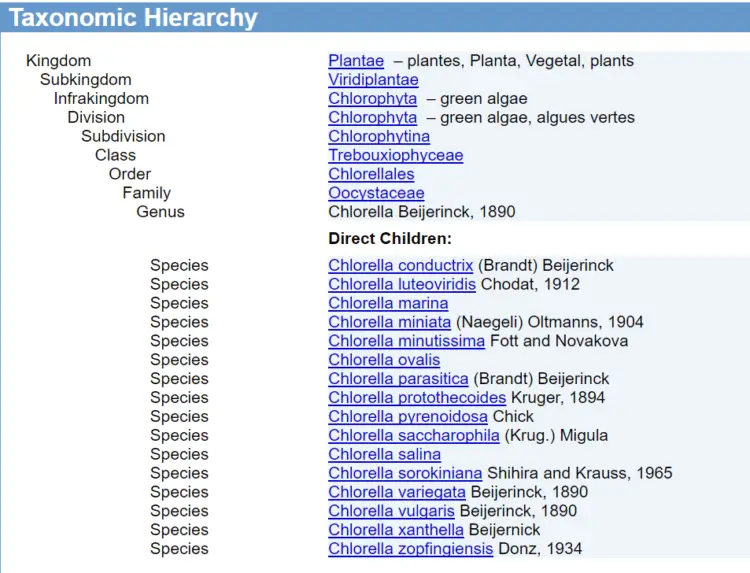Chlorella pyrenoidosa
Single-celled algae like chlorella have been around for over 2.5 billion years. Neither climate change nor natural disasters have been able to wipe them out. Chlorella is a “survival champion” and is one of the first life forms to appear on earth. But it was not until 1890 that it was identified by the biologist M.W. Beijerinck and introduced into Western science.
Phylogenetic classification of chlorella
In botany, the genus chlorella is a species of microscopic freshwater unicellular green algae from the Chlorellaceae family. It belongs to the class Trebouxiophyceae.
The scientific world distinguishes more than 100 genetically different species of chlorella. To distinguish species from each other, different characteristics are studied such as the ultrastructure and chemical composition of the cell wall, the ultrastructure of pyrenoids, physiology, morphology, molecular biology, etc. However, there is still a lot of uncertainty regarding the classification of different species.
The classification of the genre is quite chaotic. No comprehensive treatment, in which all variables have been reduced to reproducible conditions, has been attempted and, therefore, few chlorella species can be identified based on the original descriptions.
A genus and species concept of Chlorellaceae remains tentative, as, in most cases, there is still a lack of classical and molecular approaches to identify clear phylogenetic lineages.

With current screening and analysis methods, the different orders, families and genera of chlorella are determined with greater precision.
Since the first description of the type species of the genus, Chlorella vulgaris by Beijerinck in 1890, more than a hundred species of Chlorella have been described (Krienitz et al., 2004).
Traditionally, these species were attached to the genus Chlorella according to morphological criteria (Pröschold & Leliaert, 2007).
Since the 1970s, it has been accepted that Chlorella in fact constitutes a polyphyletic group: there is no common ancestor exclusive to all species. The advent of molecular analysis techniques is now causing a real upheaval in the previously established classification of these species. Today, systematists use “integrated” approaches taking into account the different elements such as molecular markers, morphology, ultrastructure and physiology.
Currently, the results show that Chlorella is divided into two classes within the chlorophyte phylum: Trebouxiophyceae and Chlorophyceae.
Within the Trebouxiophyceae, we distinguish different clades including the Chlorella-clade and the Parachlorella-clade. The phylogenetic difference between these two clades was confirmed by structural studies: wall and mode of autosporulation (Yamamoto et al. 2005).
We propose that only four species are conserved in the genus Chlorella (Chlorophyta, Trebouxiophyceae): C. vulgaris Beijerinck, C. lobophora Andreyeva, C. sorokiniana Shih. and Krauss, and C. kessleri Fott and Nováková. Common features of these taxa are glucosamine as the dominant component of the cell wall and the presence of a double thylakoid that bisects the pyrenoid matrix. (Journal of Phycology – 1999)
Numerous scientific analyzes show that not all chlorellas are created equal and that the way they are grown and processed can make a huge difference in their impact on health. However, depending on the case, producers cultivate strains of chlorella vulgaris or chlorella pyrenoidosa (or sorokiniana). And each uses specific growing methods and treatments that impact the quality of the chlorella produced.
Chlorella vulgaris or pyrenoidosa: what is the difference?
Many studies have studied chlorella pyrenoidosa and found that it is distinct from chlorella vulgaris.
Chick (1903) first described Chlorella pyrenoidosa and distinguished it from Chlorella vulgaris on the basis of the obvious presence of a pyrenoid in the chloroplast.
This research indicates that chlorella pyrenoidosa performs better because it presents
- a higher concentration of vitamins (particularly B12) and amino acids, such as choline
- higher protein content
- a higher concentration of growth factor (CGF)
Many health experts, such as the late Professor Bernard Jensen and Dr. Mark Drucker, consider chlorella growth factor (CGF) to be the most notable component of chlorella. Indeed, it provides powerful support for tissue renewal and immune defenses.

Chlorella pyrenoidosa or sorokiniana?
Some people claim that chlorella pyrenoidosa does not exist. This is in fact the consequence of inconsistencies and errors detected in certain older scientific studies.
Strains that have historically been assigned to the species Chlorella pyrenoidosa are likely misidentified. Most of the strains formerly referred to by this term have been renamed to Chlorella vulgaris, Chlorella sorokiniana or Chlorella fusca, the latter having been transferred to the genus Scenedesmus (Huss et al., 1999; Ullmann, 2006; Roshon, pers. comm.). However, the reclassification work is not finished.
It is now accepted in the scientific world that many cultures of chlorella pyrenoidosa studied in the past actually refer to what is today called the species chlorella sorokiniana.
At the level of the main producers of chlorella, analyzes and certifications made it possible to determine precisely which strains were cultivated and, when this applies, the names pyrenoidosa are gradually replaced by sorokiniana.
The species chlorella sorokiniana is named after its isolator, Dr. Constantine Sorokin, who published detailed information on this chlorella species (as Chlorellu pyrenoidosu Chick, strain 7-1 1-05) isolated from a sample collected June 10, 1951 on the campus of the University of Texas at Austin. It appears closely related, due to its rapid growth rate, to the vigorously growing Chlorella regularis. But its ability to grow very quickly at high temperatures justifies giving it the rank of species.
Bibliographic sources
- Taxonomic reassessment of the genus Chlorella (Trebouxiophyceae) using molecular signatures (barcodes), including description of seven new species – Christina Bock, Lothar Krienitz and Thomas Pröschold – Fottea 11(2): 293–312, 2011
- Phylogenetic relationship of Chlorella and Parachlorella gen. nov. (Chlorophyta, Trebouxiophyceae). Lothar Krienitz, Eberhard H. Hegewald, Dominik Hepperle, Volker A. R. Huss, Thomas Rohr, and Matthias Wolf – Phycologia: September 2004, Vol. 43, No. 5, pp. 529-542.
- Biochemical taxonomy and molecular phylogeny of the genus Chlorella sensu lato (Chlorophyta)Huss V.A.R.; Frank C.; Hartmann E.C.; Hirmer M.; Kloboucek A.; Seidel B.M.; Wenzeler P. & Kessler E. 1999. Journal of Phycology 35: 587-598.









